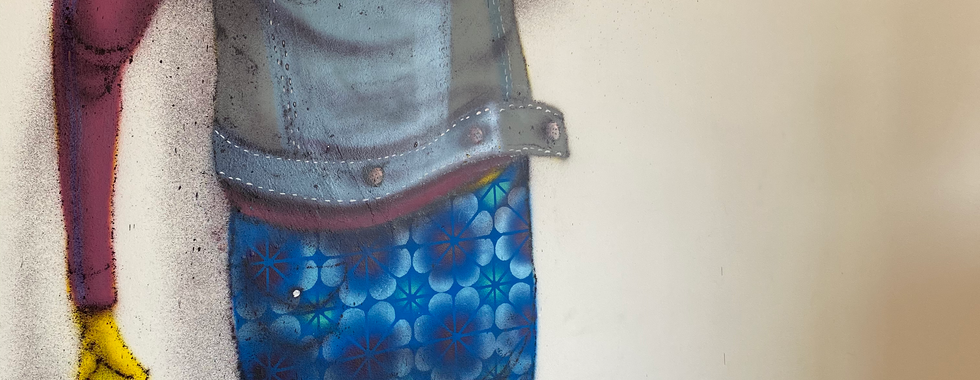USA: The World of Graffiti in Miami
- Ms. Mila Vasconcelos
- 2 days ago
- 4 min read
Updated: 1 day ago
Visiting The Museum Of Graffiti in Miami
Cultural Experiences/World Curriculum - By Ms. Mila Vasconcelos

Miami was one of the first places that I visited in 2021, when the pandemic was almost in the end and the lockdown was over. I always dreamed about visiting such a colorful place, and there was a specific area that was part of my sketchbook inspiration for years: the Wynwood Walls. When I booked my trip, I had one artistic mission in mind: to find artworks by Eduardo Kobra, my favorite Brazilian artist. But I knew the place would surprise me even more. Not only did I find Kobra’s incredible murals, but I also stumbled upon other gems: bold pieces by Os Gêmeos (The Twins), Queen Andrea (Andrea von Bujdoss), and of course amazing Bansky pieces. And to top it off? I ended up unexpectedly joining a graffiti class with a group of enthusiastic kids—proof that you're never too old to be a student, even on vacation!
One of the most interesting places I visited was the Museum of Graffiti, the first museum in the world dedicated exclusively to the history, evolution, and celebration of graffiti art. It was fascinating to learn how graffiti, once criminalized and hidden in subways and alleys, has become a global art movement, influencing fashion, graphic design, activism, and contemporary visual culture. From its roots in 1970s New York to its worldwide reach today, the museum showcases the voices and styles of pioneering graffiti artists while giving space to the newer generations who continue to redefine public art.
It was there that I had the chance to become a student again and learn more about graffiti techniques—starting with lettering and experimenting with spray paint. It was a wonderful experience that I highly recommend to any graffiti enthusiast.
The entire neighborhood known as Wynwood is located north of Downtown Miami and Overtown, and adjacent to Edgewater. The area is covered in art, the restaurants and local stores follows the same vibe, and it is possible to enjoy a meal or a snack that will have some sort of creatity inserted (see my not-so-delicious

black beans fish ice cream!). Back to the the graffitis, while some murals are permanent works that function like a museum collection, others rotate frequently, just like in a contemporary gallery. There’s even a space dedicated to the sale of artworks, inside the Wynwood Walls. There, I found myself dreaming of one day owning a Kobra piece of my own! But my biggest pleasure was just to sit on the grass, lay back and absorve the entire surrounding. I spent quite some time enjoying the dj's playing and the big Kobra mural in the background, while sketching something on my sketchbook. The entire neighborhood it's the kind of place that instantly inspires artists, educators, and creatives alike.
Back to the Art Room: What Do We Do?
This experience became the foundation for an interactive visual arts project for my 9th and 10th-grade students, centered around the themes of urban art, perspective, and graffiti lettering. Let me share how I set up the lesson plan:
Title: Graffiti Lettering and Perspective: Telling Your Story Through Street Art
Grade Level: 9th–10th
Duration: 3 weeks
Focus: Typography, spatial depth, street art culture, and self-expression
Objectives:
To understand the cultural and historical context of graffiti as an art form.
To explore one-point and two-point perspective in urban environments.
To develop a graffiti-style artwork incorporating student-created lettering and symbolic visuals.
To reflect on how art in public spaces conveys identity, community, and message.
Materials:
Sketchbooks & pencils
Rulers, vanishing point guides
Acrylic paints, spray-paint markers, paint pens
Reference images from Miami’s Wynwood Walls and featured graffiti artists
Cardboard, large drawing paper, or wooden panels
Lesson Steps:
Week 1: Introduction to Graffiti & Perspective
Explore the history of graffiti (1970s NYC, tagging culture, evolution into muralism).
Analyze artists like Eduardo Kobra, Os Gêmeos, and local Miami street artists.
Practice one-point and two-point perspective drawings, incorporating elements like walls, alleyways, or urban buildings as the foundation for graffiti placement.
Week 2: Graffiti Lettering & Personal Message
Learn graffiti letterforms: bubble, block, wildstyle, stencil.
Each student designs a graffiti name or phrase that reflects their identity, values, or hometown.
Plan layout and color schemes using complementary colors, highlights, shadows, and overlapping techniques to create depth and visual impact.
Week 3: Final Mural Creation
Students combine their graffiti lettering with a perspective background, turning it into a complete street-art style composition.
Add cultural or symbolic elements that connect to their personal narrative, community, or message.
Peer critique and class discussion about graffiti as a tool for storytelling and cultural commentary.
Why This Matters
Visiting the Museum of Graffiti and Wynwood Walls showed me that art lives in the streets, and that creative expression doesn't need to be confined to galleries or classrooms. It sparked a project in my classroom that allowed students to explore who they are, how they see their environment, and how they want to be seen by others.
I love to connect my travel experiences to my classroom practices. I try to give my students the tools to understand art in its real-world context, and invite them to see themselves as artists—not just inside the classroom, but in the world around them. And who knows—maybe one day, some of their work will end up on a wall, telling someone else’s story too. That's my hope!

Ms. Mila Vasconcelos
Arts Teacher and World-Art Explorer!































































































































Comentarios